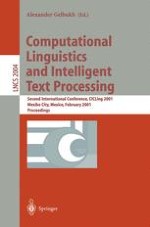CICLing 2001 is the second annual Conference on Intelligent text processing and Computational Linguistics (hence the name CICLing), see www.CICLing.org. It is intended to provide a balanced view of the cutting edge developments in both theoretical foundations of computational linguistics and practice of natural language text processing with its numerous applications. A feature of the CICLing conferences is their wide scope that covers nearly all areas of computational linguistics and all aspects of natural language processing applications. The conference is a forum for dialogue between the specialists working in these two areas. This year our invited speakers were Graeme Hirst (U. Toronto, Canada), Sylvain Kahane (U. Paris 7, France), and Ruslan Mitkov (U. Wolverhampton, UK). They delivered excellent extended lectures and organized vivid discussions. A total of 72 submissions were received, all but very few of surprisingly high quality. After careful reviewing, the Program Committee selected for presentation 53 of them, 41 as full papers and 12 as short papers, by 98 authors from 19 countries: Spain (19 authors), Japan (15), USA (12), France, Mexico (9 each), Sweden (6), Canada, China, Germany, Italy, Malaysia, Russia, United Arab Emirates (3 each), Argentina (2), Bulgaria, The Netherlands, Ukraine, UK, and Uruguay (1 each).
